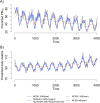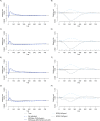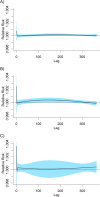Alternative adjustment for seasonality and long-term time-trend in time-series analysis for long-term environmental exposures and disease counts
- PMID: 33397295
- PMCID: PMC7780665
- DOI: 10.1186/s12874-020-01199-1
Alternative adjustment for seasonality and long-term time-trend in time-series analysis for long-term environmental exposures and disease counts
Abstract
Background: Time-series analysis with case-only data is a prominent method for the effect of environmental determinants on disease events in environmental epidemiology. In this analysis, adjustment for seasonality and long-term time-trend is crucial to obtain valid findings. When applying this analysis for long-term exposure (e.g., months, years) of which effects are usually studied via survival analysis with individual-level longitudinal data, unlike its application for short-term exposure (e.g., days, weeks), a standard adjustment method for seasonality and long-term time-trend can extremely inflate standard error of coefficient estimates of the effects. Given that individual-level longitudinal data are difficult to construct and often available to limited populations, if this inflation of standard error can be solved, rich case-only data over regions and countries would be very useful to test a variety of research hypotheses considering unique local contexts.
Methods: We discuss adjustment methods for seasonality and time-trend used in time-series analysis in environmental epidemiology and explain why standard errors can be inflated. We suggest alternative methods to solve this problem. We conduct simulation analyses based on real data for Seoul, South Korea, 2002-2013, and time-series analysis using real data for seven major South Korean cities, 2006-2013 to identify whether the association between long-term exposure and health outcomes can be estimated via time-series analysis with alternative adjustment methods.
Results: Simulation analyses and real-data analysis confirmed that frequently used adjustment methods such as a spline function of a variable representing time extremely inflate standard errors of estimates for associations between long-term exposure and health outcomes. Instead, alternative methods such as a combination of functions of variables representing time can make sufficient adjustment with efficiency.
Conclusions: Our findings suggest that time-series analysis with case-only data can be applied for estimating long-term exposure effects. Rich case-only data such as death certificates and hospitalization records combined with repeated measurements of environmental determinants across countries would have high potentials for investigating the effects of long-term exposure on health outcomes allowing for unique contexts of local populations.
Keywords: Case-only data; Environmental exposure; Long-term exposure; Seasonality; Time-series analysis; Time-trend.
Conflict of interest statement
The authors declare there is no any competing interests.
Figures





Similar articles
-
Effects of short-term exposure to air pollution on hospital admissions of young children for acute lower respiratory infections in Ho Chi Minh City, Vietnam.Res Rep Health Eff Inst. 2012 Jun;(169):5-72; discussion 73-83. Res Rep Health Eff Inst. 2012. PMID: 22849236
-
Part 1. Statistical Learning Methods for the Effects of Multiple Air Pollution Constituents.Res Rep Health Eff Inst. 2015 Jun;(183 Pt 1-2):5-50. Res Rep Health Eff Inst. 2015. PMID: 26333238
-
Multicity study of air pollution and mortality in Latin America (the ESCALA study).Res Rep Health Eff Inst. 2012 Oct;(171):5-86. Res Rep Health Eff Inst. 2012. PMID: 23311234
-
Time series analysis in environmental epidemiology: challenges and considerations.Int J Occup Med Environ Health. 2023 Dec 15;36(6):704-716. doi: 10.13075/ijomeh.1896.02237. Epub 2023 Oct 2. Int J Occup Med Environ Health. 2023. PMID: 37782034 Free PMC article. Review.
-
Comparison of alternative modelling techniques in estimating short-term effect of air pollution with application to the Italian meta-analysis data (MISA Study).Epidemiol Prev. 2006 Jul-Oct;30(4-5):279-88. Epidemiol Prev. 2006. PMID: 17176943 Review.
Cited by
-
Sexual Violence Trends before and after Rollout of COVID-19 Mitigation Measures, Kenya.Emerg Infect Dis. 2022 Dec;28(13):S270-S276. doi: 10.3201/eid2813.220394. Emerg Infect Dis. 2022. PMID: 36502433 Free PMC article. Review.
-
The impacts of diagnosis-intervention packet payment on the providers' behavior of inpatient care-evidence from a national pilot city in China.Front Public Health. 2023 Jun 1;11:1069131. doi: 10.3389/fpubh.2023.1069131. eCollection 2023. Front Public Health. 2023. PMID: 37325323 Free PMC article.
-
Heat-related mortality and ambulance transport after a power outage in the Tokyo metropolitan area.Environ Epidemiol. 2024 Feb 19;8(2):e292. doi: 10.1097/EE9.0000000000000292. eCollection 2024 Apr. Environ Epidemiol. 2024. PMID: 38617431 Free PMC article.
-
Impact of extreme ambient temperatures on low birth weight: Insights from empirical findings in Pakistan.Womens Health (Lond). 2025 Jan-Dec;21:17455057251341723. doi: 10.1177/17455057251341723. Epub 2025 Jun 5. Womens Health (Lond). 2025. PMID: 40470608 Free PMC article.
-
Hospitalization risk and burden for cause-specific cardiovascular diseases following tropical cyclones: A multicountry study.Sci Adv. 2025 Aug;11(31):eadr0800. doi: 10.1126/sciadv.adr0800. Epub 2025 Aug 1. Sci Adv. 2025. PMID: 40749061 Free PMC article.
References
-
- Sera F, Armstrong B, Tobias A, Vicedo-Cabrera AM, Åström C, Bell ML, Chen B-Y, de Sousa Zanotti Stagliorio Coelho M, Matus Correa P, Cruz JC. How urban characteristics affect vulnerability to heat and cold: a multi-country analysis. Int J Epidemiol. 2019;48(4):1101–1112. doi: 10.1093/ije/dyz008. - DOI - PubMed
Publication types
MeSH terms
Substances
Grants and funding
LinkOut - more resources
Full Text Sources
Other Literature Sources
Medical

